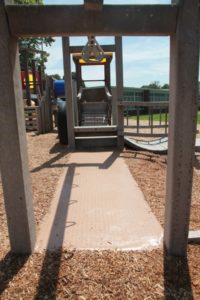The Value of Engineered Wood Fiber For Playgrounds & Trail Surfaces
Engineered wood fiber (EWF) is still a commonly used playground and trail surface because of its low, initial cost, its good impact attenuating characteristics and ability to knit together for accessibility purposes. Those terms are commonly used along with this popular surface but another term that comes to mind is maintenance. Ask most playground owners and operators and it’s commonly thought that more maintenance is just a trade-off for the low initial cost of EWF.
But for Zeager Bros. Inc., a national manufacturer of EWF located in Middletown, Pa it’s more a matter of educating playground owners and operators about products that can lower their time spent raking and leveling areas that are common problems with a loose fill surface such as EWF and how to best use them to get the most for the dollars spent.
Take for instance wear mats. Yes, wear mats in high traffic areas such as swing and slide exits are used to help reduce holes and limit maintenance. But don’t stop there; ground-level components like play panels and transfer platforms that are designed for those with disabilities will stay accessible longer and require less maintenance if you place mats below them.
Will installing some wear mats in a few areas on the playground end a playground owner’s responsibility of keeping their playground safe and accessible? Not exactly! Here are a few questions to ask the manufacturer before you purchase those mats;
Q: How do I install them so they will meet accessibility guidelines?
A: A common mistake is that most manufacturers say to just throw their mats over top the surface or worse yet, bury them beneath the wood fiber. ADA guidelines call for entrance and exits of accessible equipment to be virtually level (<2%). Typical rubber mats that can’t be anchored don’t stay in place very long and are really useless unless someone checks on them frequently.
Zeager offers wear mats that have flaps that are anchored into the surrounding surface and help to keep an even transition between the surrounding surface and the mat. The flaps also help to keep the surfacing below the mat in place which gives optimum impact safety. The anchor system holds the mat in place, keeping the area accessible and vandal proof.
Q: Do I affect the impact value of my surface by placing a mat over top the surface?
A: Ask your vendor if they have impact testing showing their wear mat passes ASTM F1292 test standard for impact attenuating surfaces for in and around playground equipment. This standard tests for impact values of the mat over top certain thicknesses of EWF at 3 temperatures – 25F, 70F & 120F. This assures that no matter what time of year, your children are less likely to suffer a life threatening head injury should they fall. IPEMA ( the International Play Equipment Manufacturers Assoc.) provides a third party certification program that you can receive a certificate showing that your wear mat meets safety standards performed by an independent lab. Go to www.ipema.org for information. Zeager wear mats are IPEMA certified!
Q: Wear mats seem to be available for common pieces of equipment like swing bays and slide exits but what about other types of equipment like large spinners, overhead ladders, track rides and the like?
A: The best thing to do is just ask your vendor! Common sizes available are 3’x3’ for slide exits, 3’x6’ for individual swings, 6’x8’ for a typical swing bay and in some cases a 6’ square or round mat for tire swings or spinner toys. But if you have an area like under a track ride or overhead rings, a long narrow mat for example would be nice (picture on right). Placing a few 3’x6’ swing mats head to head may help but they probably will get moved and not protect the area very well.
Zeager has created a customized wear mat that can cover these odd-shaped, highly used areas and keep them safe, seamless and accessible. The system uses a unique anchoring system that is safe and won’t allow the mat to be moved but also allows for maintenance down the road to be performed without a lot of hassle.
So if you’re worried about stretching your budget you don’t have to trade low cost for functionality. There are accessory products out there that allow you to keep your Engineered Wood Fiber playground surfacing while maintaining safety and accessibility!
Jeff Mrakovich
Research & Development
Zeager Bros., Inc.



